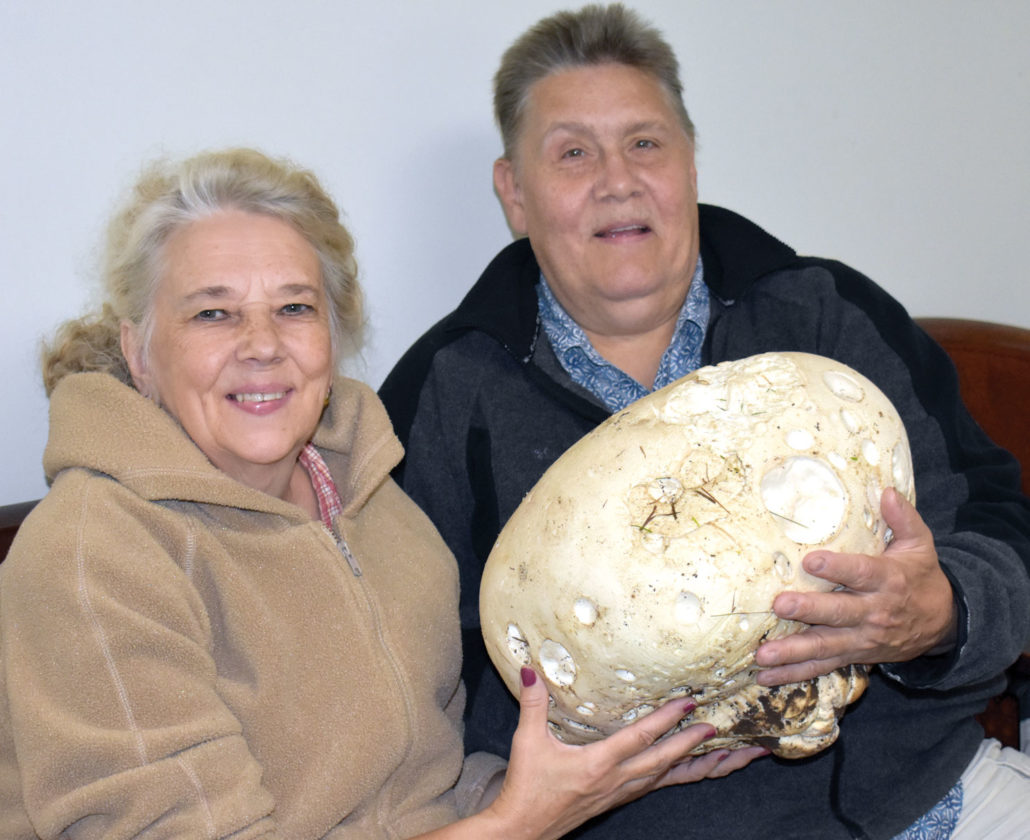Fall is prime season for mushroom hunting
- Joe Arcand and his wife, Kay, both of Quinnesec, show off the massive puffball mushroom he found earlier this week somewhere in Dickinson County. Fall is a prime time to go looking for these giant puffballs, which are edible, if all white, and have no poisonous lookalike to worry about, Joe Arcand said. (Betsy Bloom/Daily News photo)
- A mosaic-type darner — possibly a shadow darner, though several species look very similar — hovered long enough to get a close-up flying photo at Six Mile Lake in Dickinson County. Like monarch butterflies, some of these large dragonflies are known to migrate. (Betsy Bloom/Daily News photo)

Joe Arcand and his wife, Kay, both of Quinnesec, show off the massive puffball mushroom he found earlier this week somewhere in Dickinson County. Fall is a prime time to go looking for these giant puffballs, which are edible, if all white, and have no poisonous lookalike to worry about, Joe Arcand said. (Betsy Bloom/Daily News photo)
Prime mushroom spots apparently are like favorite fishing sites or White House insider stories — you don’t reveal your source.
When asked where he got such a monster puffball earlier this week, Joe Arcand replied with a laugh, “In the woods.”
While spring morels tended to get the headlines, fall really is the prime season for mushroom hunters, said Arcand, an admitted avid fan of edible wild fungi. More varieties are available this time of year for those who know what they’re looking for, such as the meadow mushrooms he’s already collected by the bagful; they are closely related to the commercially grown button mushrooms sold in grocery stores.
The recent rain should really bring on the fall bonanza. Also out there are yellow-gold chanterelles, the coral-like hen of the woods and related orange-colored chicken of the woods, porcinis, odd-shaped lobster fungus and oyster mushrooms that grow like scalloped shelves on logs.
And the giant puffball, aptly described as looking like volleyballs have sprung up in the forest.

A mosaic-type darner — possibly a shadow darner, though several species look very similar — hovered long enough to get a close-up flying photo at Six Mile Lake in Dickinson County. Like monarch butterflies, some of these large dragonflies are known to migrate. (Betsy Bloom/Daily News photo)
But Arcand and others strongly caution about indulging in this gourmet hobby without knowing exactly what is edible and, more crucially, what is poisonous. Some mushrooms can cause catastrophic damage to liver and other internal organs; milder ones still will mean a night of uncomfortable gastric distress.
Michigan State University Extension recommends:
— Never eat any mushroom unless you are positive about the identification;
— Cook all mushrooms thoroughly and never eat a wild mushroom raw;
— Be careful the first time you eat a new mushroom — only consume a small amount and wait several hours to make sure there is no reaction. Some mushroom species react with alcohol, so be sure you know which ones do, and avoid alcohol for two to three days when planning to eat those species.
— Save a small portion of any new mushroom consumed that can be taken to medical staff if someone becomes sick.
— Never try mushrooms that are not considered generally safe to eat. For more information on edible mushrooms, go to Midwest American Mycological Instruction or download the “Don’t Pick Poison” guide to poisonous mushrooms in Michigan at http://www.midwestmycology.org/Mushrooms/Don%27t_pick_poison-1.pdf.
The general rule of thumb is, the prettier the mushroom, the more likely to be toxic, said Arcand, who has been pursuing wild mushrooms since he was 21. Those bright colors and spots are a warning — not unlike the poison frogs of South and Central America, he noted.
Better yet, if just starting out in mushroom hunting, do it with an experienced guide.
But puffballs are a safe starter for those looking to try mushroom hunting, as they have no real look-alike that might cause confusion. As long as they are completely white inside and out, and have the tough outer layer peeled off, they can be sliced up and prepared as desired.
“Cut ’em up like steaks,” he said. “Fry ’em up like pancakes.”
While this large one looked fairly decent and smelled good, Arcand said the smaller ones tend to be tastier.
*****
An update on migration: Northern Wisconsin — and by extension, the U.P. — saw a major movement of birds Thursday morning, with the bulk of the warblers now having reached southern Wisconsin, said Ryan Brady, conservation biologist for the Wisconsin Department of Natural Resources office in Ashland, Wis. This region likely has seen the last of the orioles and rose-breasted grosbeaks for the year.
But some hummingbirds remain. Feeders ideally should stay out unless there’s a threat of freezing, to help out any late stragglers.
Conversely, some of the region’s winter resident birds, such as purple finches and juncos, are reappearing.
On area lakes, watch for unusual grebes — the larger red-necked, plus smaller horned and eared — and different ducks and geese that might make a pit stop while headed south.
The insect migrants — monarch butterflies and several species of dragonflies — are moving through as well, though many have already departed. Six Mile Lake still had a number of mosaic-type darner dragonflies patrolling along the shoreline, though not as many as were present in late August.




